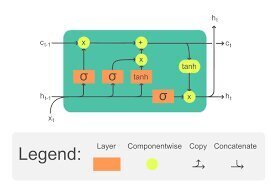Long Short-Term Memory (LSTM) networks are a type of recurrent neural network (RNN) designed to handle the vanishing gradient problem that plagues traditional RNNs. LSTMs excel in capturing long-term dependencies in sequential data, making them highly effective for tasks such as machine translation, speech recognition, and time series forecasting[1][2].
LSTM Architecture
An LSTM network consists of memory cells and three types of gates: input gate, forget gate, and output gate. These components work together to control the flow of information:
- Memory Cell: Stores information over long periods.
- Input Gate: Determines what new information should be stored in the memory cell.
- Forget Gate: Decides which information should be discarded from the memory cell.
- Output Gate: Controls what information is output from the memory cell based on current input and the cell state[1][4][5].
Working Mechanism
The LSTM network maintains a cell state that acts as a conveyor belt, allowing information to flow unchanged. The gates regulate this flow of information:
- Forget Gate: Uses a sigmoid function to decide which parts of the cell state to forget.
- Input Gate: Uses a sigmoid function to decide which values to update and a tanh layer to create new candidate values.
- Output Gate: Uses a sigmoid function to decide which parts of the cell state to output, followed by a tanh function to scale the output[1][2][4].
Applications
LSTMs are widely used in various domains due to their ability to learn long-term dependencies:
- Natural Language Processing (NLP): Machine translation, language modeling, text summarization.
- Speech Recognition: Converting speech to text, command recognition.
- Time Series Prediction: Forecasting future values based on past data.
- Video Analysis: Understanding actions and objects in video frames.
- Handwriting Recognition: Recognizing handwritten text from images[1][4][5].
Advantages
LSTMs address the limitations of traditional RNNs by:
- Overcoming the vanishing gradient problem through constant error flow within memory cells.
- Maintaining long-term dependencies by selectively retaining and discarding information.
- Being versatile in handling various sequential data tasks[1][2][5].
Overall, LSTMs represent a significant advancement in the field of deep learning, providing robust solutions for complex sequence prediction problems.
References
[1] GeeksforGeeks – What is LSTM – Long Short Term Memory?
[2] Machine Learning Mastery – A Gentle Introduction to Long Short-Term Memory Networks by the Experts
[4] Simplilearn – Introduction to Long Short-Term Memory(LSTM)
[5] Wikipedia – Long short-term memory
Further Reading
1. What is LSTM – Long Short Term Memory? – GeeksforGeeks
2. A Gentle Introduction to Long Short-Term Memory Networks by the Experts – MachineLearningMastery.com
3. Understanding LSTM Networks — colah’s blog
4. Introduction to Long Short-Term Memory(LSTM) | Simplilearn
5. Long short-term memory – Wikipedia
Description:
Handling long-term dependencies in sequential data.
IoT Scenes:
Predictive analytics, speech recognition, and complex time-series predictions.
Time-Series Forecasting: Predicting future sensor readings or usage patterns.
Anomaly Detection: Identifying unusual patterns in time-series data from various sensors.
Health Monitoring: Analyzing sequential health data for early detection of conditions.
Supply Chain Management: Forecasting inventory needs and logistics based on historical data.


